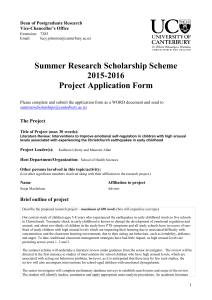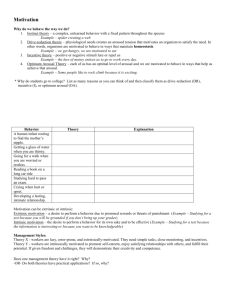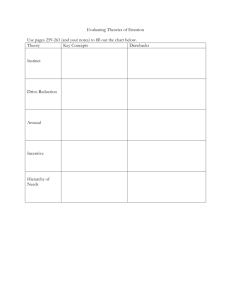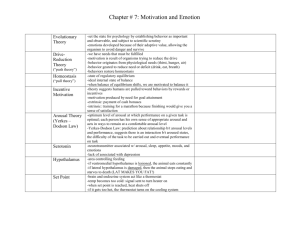Arousal theory - The Personality Project
advertisement
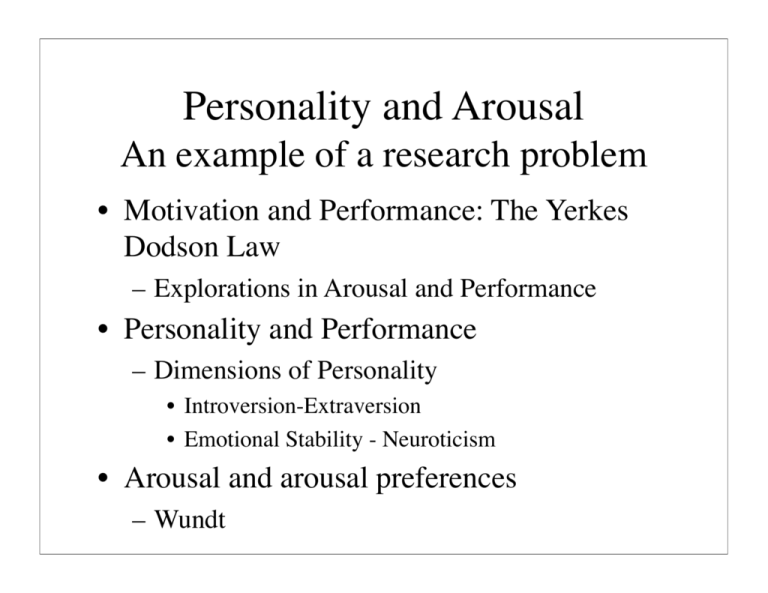
Personality and Arousal An example of a research problem • Motivation and Performance: The Yerkes Dodson Law – Explorations in Arousal and Performance • Personality and Performance – Dimensions of Personality • Introversion-Extraversion • Emotional Stability - Neuroticism • Arousal and arousal preferences – Wundt Behavioral Consequences of arousal differences • Differences in Arousal preference – Wundt’s curvilinear hypotheses • Moderate levels of arousal are more pleasing than extreme levels • (“the Goldilocks hypothesis”) – Berlyne • Changes in arousal are more pleasing than a steady state • Increases or decreases are pleasant Wundt’s hedonic curve Hedonic tone -> (adapted from Berlyne) Pleasant Boring Frightening Arousal potential -> Berlyne’s hedonic curve (adapted from Berlyne) Hedonic tone -> Calming Exciting Adaptation to Current State Frightening Boring Arousal potential -> Wundt’s hedonic curve + Individual Differences (adapted from Eysenck) Hedonic tone -> Pleasant Introverts Boring Extraverts Frightening Arousal potential of situation -> Yerkes Dodson “Law” • Electric shock as drive inducer – 4-5 levels of shock • Discrimination Learning – 3 levels of difficulty • Performance as interactive effect of difficulty and drive • Interpreted as inverted U relationship between arousal and performance Yerkes and Dodson, 1908 Discrimination learning Yerkes and Dodson Learning and shock level Yerkes and Dodson, 1908 Yerkes and Dodson curve in terms of arousal and task difficulty Performance Easy Moderate Hard Arousal - > Arousal and Performance • Broadbent and the Applied Psychology Unit – Sleep deprivation – Noise – Stress • Common theme of arousal – Problems with arousal: • Is it a unified construct? • Arousal of the hand, the heart, the head Personality and Arousal • Introvert-Extravert differences map into levels of arousal – Introverts perform as if more aroused – Extraverts perform as if less arousal • Eysenck and Arousal theory of I-E – Introversion-extraversion and arousal – Optimal arousal theory – Extraverts seeking to increase stimulation, introverts to reduce it Does Personality make a difference? • Important Life Criteria – Longevity (Friedman et al.) – Job Performance (Hunter and Schmidt) – Psychological well being • Laboratory tasks – Cognitive sensitivities and biases (eg.,McCloud, Mathews, Matthews, etc.) – Systematic pattern of results with cognitive performance by stress manipulations (eg., Anderson, 1990; Anderson and Revelle, 1994; Revelle, Humphreys, Simon, Gilliland, 1980; Revelle, 1993) Early attempts at theory testing • Subject variable (Introversion-extraversion) • Stress manipulation (1 variable) – Noise – Sleep deprivation – Threat • Predict and observe interaction • But, 3 out of 4 effects fit theory! Performance Problem with simple studies most predictions work! Easy Moderate Hard Arousal - > Extravert -c Extravert -s Introvert -c Introvert -s Early attempt at theory testing • How to manipulate arousal? – – – – Presence of others Competition Monetary Incentives Noise Multiple levels of arousal manipulations • Combine variables into progressively more arousing – – – – – – Relaxed alone Relaxed together (group size 2) Competing together (group size 2) Competing together for money (group size 2) Competing together for money (group size 8) Competing together for money (group size 8 in noisey room) • Measurement of arousal using skin conductance Early attempt • Prediction of personality by stress manipulation • With 6 levels of stress, an observed interaction would confirm theory • Result: – Arousal went down as group size went up! – Performance went up as incentives increase Revelle, Amaral and Turriff (1976) • Introversion-extraversion as assessed by self report • Placebo-Caffeine to induce arousal – 200 mg of caffeine vs. 200 mg of placebo • Practice Graduate Record Exams • 3 levels of stress (repeated within subjects) – No time pressure – Time pressure + placebo – Time pressure + caffeine 19 Introversion, time pressure, and caffeine: effect on verbal performance Verbal GRE Performance 560 540 Introverts 520 500 Ambiverts 480 Extraverts 460 Relaxed Revelle, Amaral and Turriff, Science, 1976 Timed Stress--> Caffeine Gilliland’s improvement on Revelle, Amaral, and Turiff • Used new and improved form of the Eysenck Personality Questionnaire (improved from Eysenck Personality Inventory) • Used 3 levels of caffeine, dosed by body weight • Used pre-post design Gilliland does not replicate! • Complete failure to find result • post hoc reanalysis on partial set of subjects who had EPI showed the effect was there • Impulsivity, not Extraversion is critical variable • but is this data snooping, or a real effect? Extraversion, Caffeine, and Cognitive Performance Gilliland, 1976 Many failures to replicate! • Results were due to: – Adaptation to lab? • Theory predicts extraverts should be stimulated when arriving – Type of task • GREs, math, verbal analogies – Incentives of situation? Impulsivity, Caffeine, and Time of Day: the effect on complex cognitive performance AM Performance Cognitive Performance (median standard scores) 0.4 High Impulsives 0.2 0.0 -0.2 Low Impulsives -0.4 Placebo Caffeine Revelle, Humphreys, Simon and Gilliland, JEP:G, 1980 Impulsivity, Caffeine, and Time of Day: the effect on complex cognitive performance AM Performance Cognitive Performance (median standard scores) 0.4 PM Performance High Impulsives 0.2 0.0 -0.2 Low Impulsives -0.4 Placebo Caffeine Placebo Caffeine Revelle, Humphreys, Simon and Gilliland, JEP:G, 1980 Personality and Cognition: early attempts at a synthesis • Humphreys and Revelle, 1984 – Personality Traits x situational cues produce – Motivational States (arousal and on task effort) – Inverted U between arousal and performance is the result of two processes • Arousal facilitates Sustained Information Transfer (SIT) and inhibits Working Memory • On task effort facilitates SIT Simple stage model of processingPersonality effects at each stage Conceptual Stages of Information Processing Response Stimulus Stimulus Detection and Selection Stimulus Encoding Information Integration Memory of conditional probabilities of past events Feedback Loops Response Selection and Execution Personality affects each stage of processing • Introversion facilitates detection in vigilance tasks • Anxiety facilitates detection of threat terms • Depression facilitates memory for negative events • Intelligence facilitates processing speed Arousal and Performance (Hypothetical description of Yerkes and Dodson Effect 1.0000000149 0.9000000134 0.8000000119 0.7000000104 0.6000000089 0.5000000075 0.4000000060 0.3000000045 0.2000000030 0.1000000015 0 0.2000000000000002 0.4000000000000004 0.6000000000000005 00.8000000000000007 1.000000000000001 1.200000000000001 1.400000000000001 1.600000000000001 1.82.600000000000001 2 2.22.4 2.83.600000000000001 3 3.800000000000001 3.23.4 4.600000000000001 4 4.800000000000001 4.24.45.200000000000001 5.600000000000001 5 5.800000000000001 6.000000000000002 5.4 Arousal Arousal and Working Memory 1.0000000000 0.8999999985 0.7999999970 0.6999999955 0.5999999940 0.4999999925 0.3999999911 0.2999999896 0.1999999881 0.0999999866 -0.0000000149 Arousal 0.2000000000000002 0.4000000000000004 00.6000000000000005 0.8000000000000007 1.000000000000001 1.200000000000001 1.400000000000001 1.600000000000001 1.8 2 2.600000000000001 2.2 2.4 2.8 3 3.600000000000001 3.23.800000000000001 3.4 4 4.600000000000001 4.24.800000000000001 4.4 5.200000000000001 5 5.600000000000001 5.800000000000001 5.46.000000000000002 Arousal and Information Transfer 1.0000000000 0.8999999985 0.7999999970 0.6999999955 0.5999999940 0.4999999925 0.3999999911 0.2999999896 0.1999999881 0.0999999866 -0.0000000149 0.2000000000000002 0.4000000000000004 00.6000000000000005 0.8000000000000007 1.000000000000001 1.200000000000001 1.400000000000001 1.600000000000001 1.8 2 2.600000000000001 2.2 2.4 2.8 3 3.600000000000001 3.23.800000000000001 3.4 4 4.600000000000001 4.24.800000000000001 4.4 5.200000000000001 5 5.600000000000001 5.800000000000001 5.46.000000000000002 Arousal Arousal and Performance: Arousal, Working Memory and Information Transfer 1.0000000000 0.8999999985 0.7999999970 0.6999999955 0.5999999940 0.4999999925 0.3999999911 0.2999999896 0.1999999881 0.0999999866 -0.0000000149 0.2000000000000002 0.4000000000000004 00.6000000000000005 0.8000000000000007 1.000000000000001 1.200000000000001 1.400000000000001 1.600000000000001 1.8 2 2.600000000000001 2.2 2.4 2.8 3 3.600000000000001 3.23.800000000000001 3.4 4 4.600000000000001 4.24.800000000000001 4.4 5.200000000000001 5 5.600000000000001 5.800000000000001 5.46.000000000000002 Arousal Humphreys and Revelle, Psychological Review, 1984 Using simulation to test theory • Some theories can be too complicated to see all possible predictions. One solution is to write the theory as a set of complex, interacting relationships and to test whether the theory as simulated produces “real world” like results. • Examples of such simulations include the global climate change model as well as a model developed from Humphreys and Revelle. 35 Simulation study •This experiment simulates the complexity of a real research program by simulating the complex relationships between a set of observed characteristics of individuals, how they react to situations in terms of their motivational state, and how motivational state, in turn, affects cognitive performance. Prior work in the Personality, Motivation, and Cognition Laboratory at Northwestern has allowed us to formulate a complex model of human cognition in response to stress (Anderson and Revelle, 1994; Revelle, 1992; Revelle and Anderson, 1989; Revelle, Amaral and Turriff, 1976; Revelle, Humphreys, Simon and Gilliland, 1984). This simulation is based upon that work. In a sense, the simulation is a theory of the relationship between these four sets of variables (person characteristics, situational characteristics, intervening motivational states, and cognitive performance). The parameters of the model have been set to reflect empirical estimates of the strength of various relationships. Several nuisance variables have been added to more properly simulate the problems of experimental design. 36 Limited tests •This simulation of the theory may be used as a test of the theory as well as a tool for understanding the complexity of research. That is, although one may want to study the full model, because of the limitations one's time and energy, one may study only a limited aspect of the model. The student's objective is two fold: to better understand a limited aspect of a particular psychological theory, and to try to understand what are the relationships that have been specified in the model. 37 • Variables • Subject variables: – Impulsivity (0-10) – Anxiety (0-10) – Sex (Male/Female) (1/2) – Subject Number (1-100) (time of quarter effect?) • Experimental variables – Time of day (800 - 2200) – Placebo/Caffeine (0/1) • Outcome variables – Energetic Arousal (0-100) – Tense Arousal (0-100) – Performance (0-100) 38 Variables: elaboration •Drug has two levels (0=Placebo or 1=Caffeine). Caffeine is known to act as a central nervous system stimulant although it has some side effects such as tremor (Revelle, et al., 1976). •Time of Day has 15 levels (8 AM ... 10 PM or 8 ...22). Although most cognitive psychologists do not examine the effects of time of day on cognitive performance, there is a fairly extensive literature suggesting that performance does vary systematically across the day (Revelle, et al., 1980). •Impulsivity is a stable personality trait associated with making up one's mind rapidly and doing and saying things with out stopping to think. It has been shown in prior work to relate to an inability to sustain performance. Theories of impulsivity have also suggested that impulsivity is related to a general sensitivity to cues for reward and to a greater propensity towards positive affect (Gray, 1991). In this simulation, impulsivity can take on values from 0-10. •Trait anxiety is a stable personality trait associated with feelings of tension, worry, and somatic distress. Trait anxious individuals are more sensitive to cues for punishment and non-reward and are also more likely to experience negative affect than are less trait anxious individuals (Gray, 1991). In this simulation, anxiety can take on values from 0-10. •Sex of subject sometimes interacts with characteristics of the experiment (sex of experimenter, stress of experiment, type of task) and has sometimes been associated with levels of anxiety. In this study, Sex varies randomly taking on the values of 1 or 2. (Using the mnemonic of the number of X chromosomes, that is 1=M and 2=F) 39 Outcome (dependent) variables •Energetic arousal reflects self reports of feelings of energy, activity, and alertness. EA has been shown to increase with exercise and to decrease with sleep deprivation (Thayer, 1988). EA is also associated with feelings of positive affect (Watson and Tellegen, 1985). •Tense arousal reflects feelings of tension, frustration, and fear (Thayer, 1989) and is moderately associated with feelings of negative affect (Watson and Tellegen, 1985). •Performance in this simulation reflects accuracy on a simple decision task. A perfect score is 100, and performance deteriorates from that as a function of condition and motivational state. Abstractly, this may be thought of as accuracy on a vigilance task, or the ability to make accurate judgments on some sustained processing task. 40 What to test •Any experiment pits power against practicality. That is, the more subjects that are studied, the more statistical power that one has to detect an effect. However, subjects are not an unlimited resource. They are hard to recruit and they are time consuming to run. In addition, for a particular number of subjects, as the number of variables that are examined increases, the potential number of higher order relationships (interactions) increases dramatically at the same time that the power to detect these interaction decreases because of the limited number of subjects in any one condition. • •A reasonable approach is do have some theoretical reason to believe that a certain relationship exists, and then perhaps conduct a series of "pilot" studies to determine the sensitivity of certain parameter values. •The goal of this project is to try to determine at least some of the relationships that have been built into the model. You will be evaluated on principles of experimental design, not on the significance of the results. • 41 •The first 3 screens give a brief introduction to the program. You may move on to the next screen by selecting the "OK" button or pressing "Enter" or "Return". •. Data generated by the program are displayed trial by trial in appropriate dialog boxes. They are also saved in a data file that may be read by any spreadsheet or word processing program. Before you can get to this point, a dialog asking for the name of the data file will appear. The default is "Simulation.Data". If a file with that name already exists, and you choose to do so, it will be erased and the new data will replace it. If you do not want this to happen, change the name of the new data file appropriately. •At this point, the first "subject" screen appears. Values of Independent variables may either be assigned at random by the computer, or may be specified in the appropriate box. (Values that are not within the specified range will be replaced with values at the minimum or maximum acceptable). When satisfied with the selection, press "return" or click on the "OK" box. 42 Screen shots Choose parameters for one subject Output for 1 subject stopping gives some summary statistics The summary statistics are the means and standard deviations of the subjects you have run up to this point. They are not broken down by condition. sample output can be read by R, Excel, or Systat trials drug time anxiety impulsivity sex arousal tension performance IMP_2 TOD_3 1 2 3 4 5 0 0 0 0 1 19 20 15 11 9 6 5 3 5 6 5 5 5 2 5 1 70 1 70 2 66 1 60 2 58 66 46 58 54 66 83 88 90 73 65 2 2 2 1 2 3 3 2 1 1 The two variables on the right (IMP_2 and TOD_3) are recoded data with the coding system: If Impulsivity <5 then IMP_2 = 1 else Imp_2 = 2 and If Time <12 then Tod_3 =1 else if TIME < 18, then TOD_3=2 else TOD_3 = 3. Similar recoding options are available in Systat and might be more appropriate.

